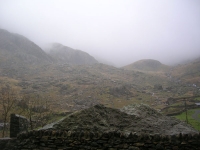The Kelpy of Morphie
In ‘Folklore of Scottish Lochs and Springs’ (1893), James Mackinlay tells the following tale of a captured water horse. ‘A pool in the North Esk, in Forfarshire, called the Ponage or Pontage Pool, was at one time the home of a water-horse. This creature was captured by means of a magical bridle, and kept in captivity for some time. While a prisoner he was employed to carry stones to Morphie, where a castle was then being built. One day the bridle was incautiously removed, and the creature vanished, but not before he ex-claimed;
“Sair back an’ sair banes,
Carryin’ the Laird o’ Morphie’s stares;
The Laird o’ Morphie canna thrive
As lang’s the kelpy is alive.”
His attempted verse-making seems to have gratified the kelpy, for when he afterwards showed himself in the pool he was frequently heard repeating the rhyme. The fate of the castle was disastrous. At a later date it was entirely demolished, and its site now alone remains.’




Re: The Kelpy of Morphie
GRAHAM OF MORPHIE.
THE old family of the Grahams of Morphie was in former times very powerful, but at length they sunk in fortune, and finally the original male line became extinct. Among the old women of the Mearns, their decay is attributed to a supernatural cause. When one of the lairds, say they, built the old castle he secured the assistance of the water-kelpy or river-horse, by the accredited means of throwing a pair of branks over his head. He then compelled the robust spirit to carry prodigious loads of stones for the building, and did not relieve him till the whole was finished. The poor kelpy was glad of his deliverance, but at the same time felt himself so galled with the hard labour, that on being permitted to escape from the branks, and just before he disappeared in the water, he turned about, and expressed, in the following words, at once his own grievances and the destiny of his taskmaster’s family–
"Sair back and sair banes,
Drivin’ the laird o’ Morphie’s stanes!
The laird o’, Morphie’ll never thrive
As lang’s the kelpy is alive!"
Scottish Fairy and Folk Tales, by George Douglas, [1901]
Re: The Kelpy of Morphie
Oxford Dictionary of Celtic Mythology:- In a widely known story a nobleman named Graham of Morphie bridled a kelpie and obliged him to drag stones to build his new castle. When the castle was completed, Graham released the unhappy kelpie who dashed to the river, promising that the Laird of Morphie would never enjoy the fruits of his forced labour. And, indeed, misfortune dogged the Grahams of Morphie all their lives.
Re: The Kelpy of Morphie
The Scottish nation; or, The historical and genealogical account of all Scottish families and surnames (Volume 2) by James MacVeigh
The Grahams of Morphie, Kincardineshire, were an offset from the noble house of Montrose. They are mentioned as an ancient branch of the house of Graham in the reign of Robert the Bruce, and they got the lands of Morphie confirmed to them by the charters of David I. In the reign of James VI., Sir Robert Graham of Morphie was knighted by his chief, John, earl of Montrose, chancellor and viceroy of Scotland, his arms being sable a chevron argent, between three escalops or. (Nisbet’s Heraldry.). Sir Robert’s daughter, Giles, married Sir William Douglas of Glenbervie, 9th earl of Angus, and was the mother of the 10th earl.
Sir Robert Graham of Morphie, his son, was one of the tutors of his kinsman the great marquis of Montrose, and in 1638 he accompanied him on his first visit to Aberdeen at the head of the army of the Covenant. He continued to adhere to him during the whole of the wars in which he was engaged in Scotland, previous to his departure for the Continent in 1646, nearly to the ruin of his estate. In 1661, when Montrose’s head was taken down from the pinnacle of the Tolbooth of Edinburgh, Graham of Morphie was one of the five personal friends of the great marquis present to receive it.
Margaret Graham, the mother of the last Graham of Morphie, was a sister of the celebrated Graham of Claverhouse, Viscount Dundee, having married Sir Robert Graham of Morphie. That gentleman entailed what remained of the Morphie estate on his kinsman, Barclay of Balmakewan, descended, through the 2d son of David Barclay of Johnston, from the Barclays of Mathers, or Madders, afterwards of Urie, on condition of his taking the name and carrying the arms of Graham of Morphie.